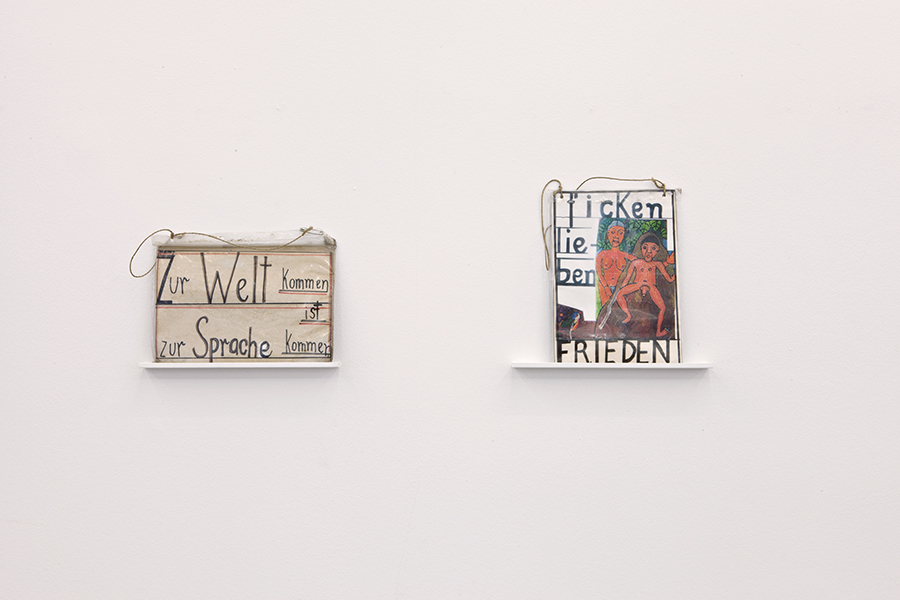What Helga Goetze’s Tapestries Teach Us About Sexual Liberation
The artist’s exhibition at Delmes & Zander, Cologne, exposes society’s fear of sexually self-determined women
The artist’s exhibition at Delmes & Zander, Cologne, exposes society’s fear of sexually self-determined women

Every day from 1983 to 2007, a woman with homemade banners bearing crude vocabulary stood in front of Berlin’s Kaiser Wilhelm Memorial Church, where she campaigned for sexual liberation. Born between the wars, for many years German artist Helga Goetze lived the life of a busy wife and mother of seven, until she experienced her first orgasm while having an affair during a holiday in Italy in the early 1970s. From then on, she broke with the institution of marriage, lived her promiscuity without inhibition and agitated loudly against the social proscription of female pleasure until she died in 2008.
Consisting of tapestries, collages and protest signs, Goetze’s current exhibition ‘Ficken ist Frieden’ (Fucking is Peace) at Delmes & Zander in Cologne is the first to provide an overview of her various artistic practices and their links to her sex-positive activism, revealing the cosmos behind ‘Germany’s super-bitch’, as she called herself with reference to a tabloid headline.
Her political placards add depth to the image of a supposedly nymphomaniac provocateur. On the one hand they display rather simple slogans like ‘fucking, love, peace’ (Ficken Lieben Frieden, undated), on the other, they also feature epistemological statements like ‘entering the world means entering language’ (Zur Welt kommen heißt zur Sprache kommen, undated), referring to German philosopher Peter Sloterdijk’s similarly titled 1988 book. This should be understood programmatically: the vulgar vocabulary that Goetze used was meant to pre-empt any linguistic enclosure of female desire and expose society’s fear of sexually self-determined, assertive women. Those who don’t switch off at ‘fucking’, then, can find a whole lot of ‘love’ and ‘peace’ waiting beyond.

left: Helga Goetze, Ficken Lieben Frieden undated Archive #008, mixed media, 30 × 23 cm. Courtesy: the artist and Delmes & Zander, Cologne; photograph: Johannes Post
The tapestries take a similar approach: though they show no end of copulating couples, bared breasts and erect penises, they do not conform to the usual logic of erotic imagery. Gewerkschaftsteppich (Union Tapestry, 1989), for instance, shows a female life cycle based on an ideal state of nature. The always-naked female bodies nestle up to the natural landscape and use it as a playground for sexual exercise, sketching a society where a higher level of consciousness can be accessed via physical desire. Image and text interlock to form a diagram in the shape of a flower. Overall, Goetze cultivated the kind of naive, pleasantly-tempered visual idiom that can often be found in murals at primary schools or community centres. In her case, however, this pedagogical style seems appropriate as it more strongly underlines Goetze’s efforts to educate on the subject of sexuality.

The largest tapestry in the exhibition, Indianische Astrologie (Indian Astrology, 1984–85), takes this style to an expressivity that distinguishes it from the diagrammatic approach of her other works. Here, men and women take on the role of solar beings whose sexuality provides light and warmth, giving life to fauna and flora. This dream of an orgiastic paradise is reminiscent of new age eroticism, but one gets the feeling that Goetze needed this kind of reassuring utopia in order to defy the hatred and malice of her opponents.

At first glance, it might seem irritating that Goetze focused on embroidery, a technique traditionally associated with the oppression of women. But it would be a mistake to think that women artists could only close the gap between themselves and their male colleagues by using the same materials. Goetze pushed the boundaries by drafting a version of femininity in which all facets were acknowledged – including the sexual ones. She didn’t want to overcome men; she wanted to fuck them, to love them and integrate them into a harmonious state. ‘Ficken ist Frieden’ shows us that Goetze was not interested in satisfying personal needs or simple self-realization – there were easier ways she could have achieved that. Instead, she was addressing the whole of a sexually frustrated, embittered society, whose smallest unit she saw in the regularly copulating couple.
Translated by Nicholas Grindell
Helga Goetze, ‘Ficken ist Frieden’ runs at Delmes & Zander, Cologne, until 30 October 2019.
Main image: Helga Goetze, Indianische Astrologie, 1984-1985, embroidery, cotton twist, metal thread and nettle, 126 × 180 cm. Courtesy: the artist and Delmes & Zander, Cologne; photograph: Johannes Post






















